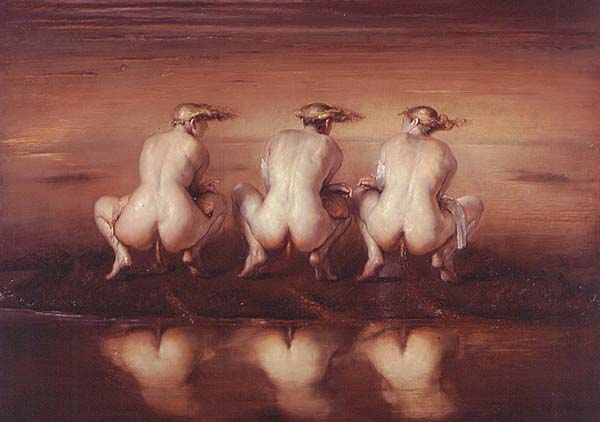Sometimes things become intertwined in a full circle that initially escapes us since the assumed understanding is based on enlightenment principles guided by the linear progression of science and technology where evolution is rational and explainable. In Donald Kuspit’s The End of Art and an essay on the art market, there is asserted a valid thesis that art values have been completely subsumed by corporate values whereby the two are identical, even art as a glorified high-class form of financial public relations. That meta-kitsch is our dominant aesthetic and spiritual value and the future has too many cracks in the foundation; we are letting in bugs and human waste and not light.

Gerome. Slick technique and anecdotal interest. The woman, being naked for legitimate reasons, could be ogled. What more could you ask? Fallacy sells. Manet did not enjoy the same critical response. Honesty was always a dangerous policy in the Salon. Image:http://www.shafe.co.uk/art/Gerome-_Pygmalion_and_Galatea-_1882.asp
A similar situation existed with French Salon art where painting became a mathematical formula for beauty and the defenders of the art market were insulating what they thought was the purity and sanity of their business against the attacks of the great unwashed who were essentially regarded as boors, or madmen. Today’s Damien Hirst’s, McCarthy’s et al. were yesterday’s pedants of the French Academy; a closed circle of conventional talents who are skillful at manipulating trite formulas and play the p.r. game with aplomb. The small group of buyers that had their head loped off by the French Revolution are back as the corporate purchaser.

As usual with Rockwell, more complex than it appears, yet it still reatains the qualities of sentimental, contrived tackiness. ---Perhaps the most revelatory aspect of the list is the nearly equal commercial value accorded Warhol, Rockwell and Bacon. It conveys the breakdown of difference between popular commercial and fine art, which in fact occurred almost simultaneously in the work of all three artists. This is evident if one looks at their iconographic sources, implied public and even handling, which is relatively unnuanced -- even simplistic -- from a fine art point of view. ---Read More:http://www.artnet.com/magazineus/features/kuspit/kuspit3-6-07.asp
Now, as in Salon times,there is a love affair between affluent purchasers with ordinary, formula, and mediocre taste and sometimes skilled artists pandering to them with mediocre conceptions tied together with a pop art version of anecdotal interest: the gimmick, sentimental moralizing and above all, intellectual pretension. What Duchamp did was transform the anecdote into a ready-made, more flattering to the observer, and perversion, misogyny etc. could be legitimized in an updated version that could stake a claim to cultural elevation. Flattering the observer as culture.

Napoleon III bought Cabanel's Birth of Venus out of the Salon in 1863.Cabanel's painting suggests one thing and one thing only, but since she was a Venus conventionally and quite skillfully painted by a high ranking academician, everything was alright. image:http://www.artcyclopedia.com/artists/cabanel_alexandre.html
In the old days, armies of nudes filled Salon walls; girls stark naked but disguised by titles and accepted by bourgeois tastes since culture usually more than made up for moral wantonness and nothing like lines of great purity to make artistic subterfuge deliciously appealing. Salon painters very very ingenious in finding hundreds of ways to involve nudes in acceptable anecdotal situations; the women were always being sold into slavery, having their teeth examined, lashed to a stake or languished in bondage while indifferent guards stood idly by. Kind of like men’s pulp magazines in the hey-day. Women couldn’t disrobe for a quick dip without being taken by surprise; but they resented this and expressions of outraged modesty allowed Salon purchasers the dose of moral sympathy and a more concealed response to their charms.

---maybe Duchamp liked looking at menstrual blood, the way other men, according to the Marquis de Sade -- a Surrealist hero, as Man Ray's adulatory image of him suggests -- like looking at women squatting and urinating or defecating, sometimes into the mouths of the men. Odd Nerdrum shows them defecating in what looks like homage to the sun. But the long stool looks like a penis, suggesting that Nerdrum also worships the phallic woman.---Read More:http://www.artnet.com/magazine/features/kuspit/kuspit6-10-02.asp
Technically extraordinary painters like Edward Landseer would waste their talent turning out hack work of cows animals with all the pompous airs of a landed baron with sensitive intelligence and subtle emotional response. It was a pathetic fallacy: the Sarah Bernhardt of taxidermy much like Damien Hirst with his sharks and cattle. Ultimately, to save time on the analysis, the rank and file of Salon painting was trite, obvious and vulgar: kitsch. Like most modern art today.
Donald Kuspit:Money supposedly has no value in itself, that is, it is valuable for what one can exchange it for, but I will suggest the surge of art buying is money’s parthenogenetic way of saying that it is valuable in itself, indeed, value distilled to purity, the quintessence of value in capitalist society….
/wp-content/uploads/2012/03/koons5.jpg" alt="" width="540" height="571" />
Jeff Koons. I don't see that much difference between this and a Salon artist like Vibert who represented anecdote ad finitum of roman cardinals in humorously undignified situations or taken aback by the worldy pranks of their parishioners. Image:http://www.wikipaintings.org/en/jeff-koons/woman-in-tub








 COMMENTS
COMMENTS



